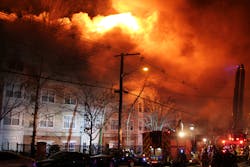We are an occupation that thrives on lists. From station locations to inventories and tactical worksheets to mnemonics, lists serve as adjuncts to help us remember critical factors that promote solid performance in routine and emergency situations. Lists are the solder that connect the neurons of our brain and contribute to informed, well-rounded firefighters.
One such list is famous—or actually infamous—fires. We have all spent at least a cursory amount of time studying significant fires in history that played a role in molding the American fire service. This list includes the Great Chicago Fire, Great San Francisco earthquake and fire, Cocoanut Grove Night Club Fire, Hartford Circus Fire, Our Lady of Angels School Fire and the Bel Air Fire, to name a notable few. The fires were epic, each in its own right, but are now so distant in our history that they can tend to feel like novelties because we have little to no direct connection to them.
There exists an endless number of other fires that are not part of our general memory but deserve being spotlighted and studied, as the details and lessons are more recent, tangible and every bit as compelling as their better-known and long-studied predecessors.
The six fires that follow were selected because of their impact on departments and communities, similarities in scope that make them almost interchangeable or because there is a personal element. The first paints a compelling argument for comprehensive cancer prevention measures and presumption protection. The next four discuss modern fire behavior in a prevailing method of construction. The final fire is a little elusive, as it will vary for each reader, but it is no less important in the learning curve that we call firefighting knowledge and experience.
Wade Dump fire—Chester, PA
An unscrupulous entrepreneur in the city of Chester, PA, converted a declining rubber-reclaiming plant to an illegal chemical dump. The owner colluded with an equally nefarious trucking company that hauled hazardous waste from nearby chemical plants and allowed the waste to be dumped at the plant under the noses of government officials. The Wade Dump, as the site became known, contained “... at least 3 million gallons of cyanide, PCBs, benzene, toluene and other chemicals …” (Stranahan, et. al., 2000) dumped directly onto the ground as well as stored in 55 gallon drums, recklessly stacked and intermingled inside the plant building and the yard area. Local, state and federal officials were aware of the dump, but failed to tell the Chester Fire Department.
On Feb. 2, 1978, CFD crews were dispatched for a fire at Eastern Rubber Reclaiming, Inc. Responding crews initially believed that they were responding to a tire fire. They arrived to find a well-developed fire in the three-acre complex pumping clouds of noxious black smoke that seemed peculiarly acrid, even for tires burning. The crews mounted an aggressive attack but were driven back due to multiple explosions of the swollen, rusting drums and the immediate effects of the disabling smoke. The 200-plus firefighters, police officers and paramedics were enveloped in the toxic smoke cloud, showered with unknown liquids when the drums exploded, and knocked into pools of iridescent liquid from the concussion of the exploding drums. The short-term exposure effects were debilitating: raw, burning throats, vomiting, a quickly forming red, itchy rash, and seared eyes and nasal passages.
Miraculously, no firefighters died the night of the raging fire or in the ensuing days of fire watch and cleanup. However, in the years that followed, a horrific toll emerged. One in five of the first responders on scene began contracting sinister and seemingly inexplicable varieties of cruel cancers as well as vascular, neuromuscular and kidney diseases. By 1988, 21 cancers were diagnosed among responders who worked the fire or the cleanup after. Eleven died. Between 1988 and 2000, 18 additional cancers had appeared, killing nine more of the responders. Cancer rates among the group at the fire are five to six times the norm, with cancers such as melanoma occurring in odd places on the firefighters’ bodies.
The cause of the fire was never determined, but its legacy slowly eviscerated the Chester fire and police departments and EMS system of active and retired members, cutting down some in their prime and robbing others of hard-earned retirements.
The Wade Dump Fire was a catalyst for Superfund legislation. For the responders, the legislation was too little, too late. Finger-pointing over who knew what when and acrimony over political promises that went unfulfilled after the fire rang hollow and overshadowed the suffering among the first responders. The fire serves as a grim reminder that the risks associated with firefighting are far more insidious than the acute effects of visible smoke, heat and flames.
One Chester firefighter at the scene who waded through the toxic muck and inhaled an unknown amount of smoke and fumes was diagnosed with melanoma on his foot (an unusual location for the disease) and cancer of the larynx just three short months after the fire. He was the beginning of a long line of dedicated but unsuspecting firefighters, police officers and paramedics who contracted cancer at alarming rates over the course of the next 20 years.
The Wade Dump Fire should be included as compelling evidence in the pitched battles taking place in states wrestling with cancer presumption for firefighters. The tragedy that unfolded in the ensuing decades after the fire in Chester was extinguished is far too great to be “just a coincidence,” earning the Wade Dump a place on every firefighter’s “need-to-know” list.
Mini-Conflagrations
There’s no one left to offer firsthand accounts of the great conflagrations that spurred changes in the fire service and fire safety still in use today. However, four fires occurring in 2014 and 2015 provide more recent, albeit smaller-scale, models that tie them through common factors to more notable 19th- and early20th-century conflagrations like the Great Chicago Fire, Great Baltimore Fire and Great Boston Fire. Each vividly demonstrates lessons from the past that are reinforced in 21st-century vulnerabilities: closely packed, multi-story, interconnected, lightweight constructed buildings.
Avalon on the Hudson Condominiums (Edgewater, NJ): The Avalon on the Hudson Condominiums was a fully occupied, 400-plus-unit luxury complex. The fire was reported at 1620 hrs on a cold Jan. 21, 2015. Five hours later, the massive complex was in ashes and hundreds of occupants were displaced. Firefighters were first hampered by frigid conditions and access issues, then overwhelmed by a fast-moving, wind-driven fire. The complex was no stranger to fire. A significant fire occurred there while under construction in 2000.
The following three fires occurred in structures in their most vulnerable state—still under construction.
Gables Upper Rock Apartments (Rockville, MD): Gables Upper Rock was sprinklered, nearly complete and scheduled to begin receiving renters within a few weeks of its fire. At 0415 hrs on April 1, 2014, Montgomery County firefighters were called out for a structure fire. Arriving crews found the 150-unit, block-long structure well involved, the fire having bypassed the protected areas. Lightweight construction, rapidly advancing fire and structural collapse put the crews in a defensive strategy from arrival. The structure was destroyed.
Da Vinci Apartments (Los Angeles, CA): The next “mini-conflagration” on the list is the Da Vinci Apartment fire that occurred in Los Angeles in the early morning hours of Dec. 1, 2014. The massive structure was a multi-story apartment complex in its open wood-framed state when it was set on fire by an arsonist. An accelerant was used to start a fire in the center of the block-long, unprotected structure. The fire quickly ate through the structure causing $25–30 million in loss to the complex, $50–60 million in damage to an adjacent city building and extensive damage to a nearby highway overpass. Lightweight, unprotected construction, wind and arson contributed to the massive loss.
Montrose Area Apartments (Houston, TX): The final fire in the “mini-conflagration” subset of our updated infamous fires list is another lightweight, wood-framed apartment complex under construction that occurred on March 25, 2014, in Houston. A viral video of a worker trapped on an upper floor captured our attention for the nanoseconds associated with today’s 24-hour news cycle, but for most people, the fire is a distant memory.
The reasons for adding these fires to our dialogue goes beyond their compelling videos. Similarities in construction type (lightweight, wood-framed), size and footprint (150–400 units plus, defined in city block terms), conditions (wind-driven), fire department response (multiple alarms rapidly summoned) and outcome (total loss in each case) give us a readily referred to and case study list of modern fires we have a closer relationship to than their 19th- and 20th-century counterparts.
Your last working fire
Experience is said to be the best teacher. That is true if the student is paying attention. In an era when structure fires are on the decline, each and every response to a working fire provides a priceless sum of firsthand, immersed contact that is fleeting at best if all we are concentrating on is the thrill of the event. Each fire—whether you are there on the nozzle, venting, staffing RIT or called in to relieve the first alarm—has lessons to file for the next fire you respond to.
Bringing it all together
The list isn’t comprehensive, and it is certainly expandable. The point is that each of the fires discussed forms a link in a chain that connects your last working fire (the most significant to you) with firefighters at other times and places in history who faced situations that can also bolster your experience. Hopefully this list gets you thinking, maybe enlightening you to a few facts you may not have known or jogging your memory about some history you once knew but hadn’t thought about in awhile. Ultimately, the goal here was to better equip you to tackle your next fire.
Take the time to investigate these events in more depth, or search out other fires of interest that you can use to become a better-informed student of the best job in the world.
Until next time—Be vigilant. Stay focused. Share knowledge. Be safe.

John B. Tippett Jr.
John Tippett, CFO, FIFireE, is the director of Fire Service Programs for the National Fallen Firefighters Foundation (NFFF). He was previously the interim chief for the Charleston, SC, Fire Department, where he served since 2009. Tippett previously spent 33 years with Montgomery County, MD, Fire and Rescue. He has extensive experience as a company officer, operations battalion chief, safety officer, instructor and chief officer. His past experience also includes 10 years with Maryland Task Force 1, a FEMA US&R team, with five years as task force leader. He has a bachelor’s degree in fire science and a master’s degree in emergency services management. Tippett has also worked extensively on national firefighter safety initiatives, including introducing crew resource management to the fire service and the National Fire Fighter Near-Miss Reporting System. He writes and lectures frequently on firefighter safety, decision-making, leadership, risk management and tactics. Tippett is an at-large board member on the International Association of Fire Chief’s Safety, Health and Survival Section, holds a certified health and safety officer credential through the Fire Department Safety Officers’ Association (FDSOA) and has earned a Chief Fire Officer Designation from the Center for Public Safety Excellence. He was the 2006 recipient of the George D. Post Instructor of the Year from the International Society of Fire Service Instructors.






